How to fix a toilet installation: popular breakdowns and how to fix them
A wall-hung toilet, like his brother's compact, can also break or begin to leak. Such a situation is not at all a sign of future expensive repairs with the collapse of the walls in the bathroom - repairing the installation for the toilet can cost a little blood. And you can always try to eliminate the problem with your own hands.
We suggest that you familiarize yourself with the methods available to independent craftsmen for troubleshooting a wall hung toilet. We list the main causes of breakdowns and “symptoms” that indicate their occurrence. Attention is paid to both the plumbing itself installed on the support frame and the fittings of the flushing cistern.
The diagnostics described in detail and the carefully described methods for restoring the performance of plumbing devices were supplemented with visual illustrations and video guides.
The content of the article:
List of traditional breakdowns
Damage to the toilet can unbalance even the most calm and good-natured person. This is not a faucet, without which you can do a couple of days using a shower head. It will not be possible to live comfortably without a toilet, so the issue of repair should be addressed promptly.
Think that costly wall-hung toilet with installation can serve without problems for ages, not worth it. Each toilet, like any other product, has its own life. In some systems, it can reach 10-12 years or more.
The life of your plumbing fixtures can be found in the manufacturer's instructions in the warranty section. If you carefully study this document, you can see that some components have a shorter service life.
So, the filter and gaskets must be replaced much earlier.
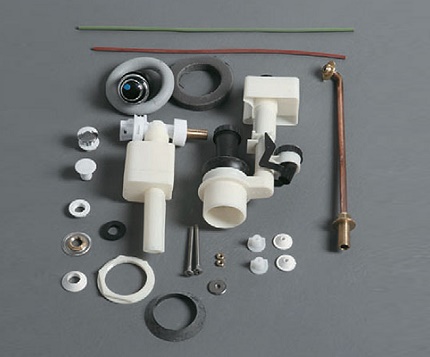
Built-in plumbing with an installation system consists of the following parts:
- frame or frame;
- cistern;
- nodes of the supply and removal of the working fluid;
- toilet / bidet / urinal.
Damage is possible in every part of the installation. To eliminate the cause of the malfunction, you must first find it. This task seems impossible without a large-scale repair. But it seems only at first glance.
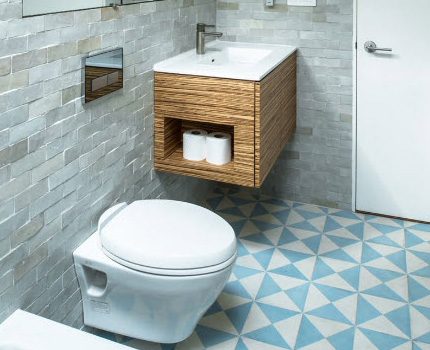
Frame or support frame It is made of durable metal on the right, and is coated with an anti-corrosion layer on top. This part is durable - I will attach all the other elements of the system to it. It is able to withstand up to 600-800 kg of load.
This characteristic will differ for each manufacturer. It is important to pay attention to the maximum allowable load before buying favorite model. Sometimes, in order to save money, they buy a cheap fake, where this figure is only 100 kg.
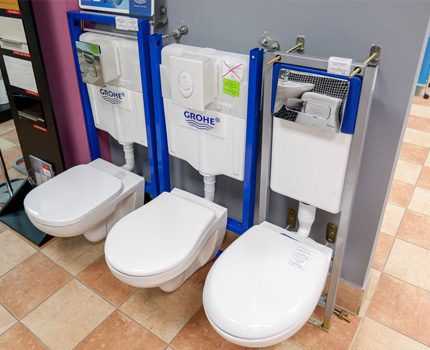
Such a frame can easily bend or crack from overloading - about 70-80 kg weight of an adult + tank of water + weight of the toilet itself. And if a large relative weighing more than 100 kg visits a bathroom, then it’s scary to imagine what will happen. Therefore, do not buy fakes - this is an impermissible luxury.
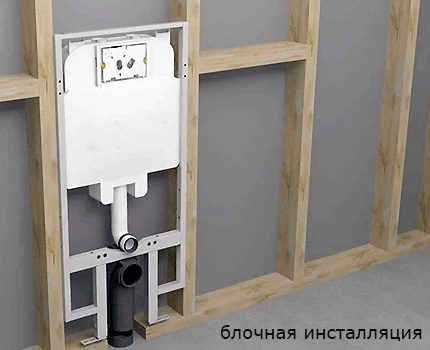
All manufacturers make a drain tank of installation from plastic. It is flat or trihedral, and inside it stands plumbing fixtures to ensure automatic filling and flushing.
What can happen to the tank:
- The plastic container may break in case of installation errors. If it was an independent installation and, due to inexperience, the installer made mistakes, the tank may warp and crack over time.
- If a krivoruky master was involved in the installation and accidentally hit it during installation, then after a short time a leak may occur at the cleavage site and it will be necessary to replace it with a new tank.
- The fittings installed inside the tank consist of plastic parts, rubber and silicone gaskets. Often problems arise due to the wear of one of the components.
Nozzle and branch nodes may leak. The coarse filter installed before water enters the drain tank clogs over time. And at the joints of all the pipes, leakage may occur - elastic rubber gaskets fail over time, turning into hard plastic parts.
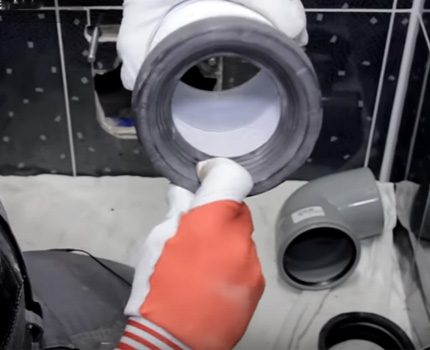
With the toilet, problems can also arise - from a usual chip, to a violation of the system for draining the working fluid into the sewer riser.
Do-it-yourself troubleshooting
To find the source of the problem that caused the toilet to go out of operation, you can resort to a plumber call, call a neighbor who helps everyone and takes inexpensively, or try to do it yourself.
The first option is safe, but requires an agreement on the time of work and will cost a decent amount of money. Of course, this is the most convenient and easiest option - you do not need to do anything, twist, change - gave money and accepted the job.
The option with a neighbor / acquaintances of acquaintances is like a cat in a poke. Doubtful quality of work can lead to even bigger problems and more serious breakdowns.
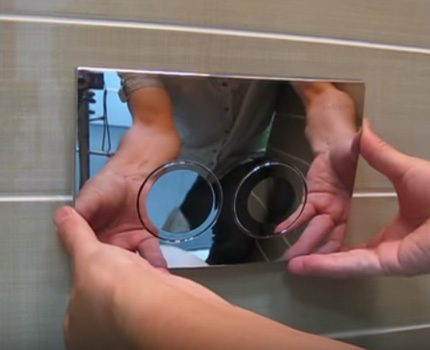
The third option involves self-study installation systemsinstalled in its bathroom and its repair. This is a simple activity that does not take haste. It is important to take the manufacturer's instructions and carefully read the relevant section. If the instructions are lost, you can search the sites of online stores or ask a plumbing store consultant.
All controversial issues that arise during the installation repair process can be viewed in thematic video clips. Armature models of built-in reservoirs of different manufacturers may differ from each other.
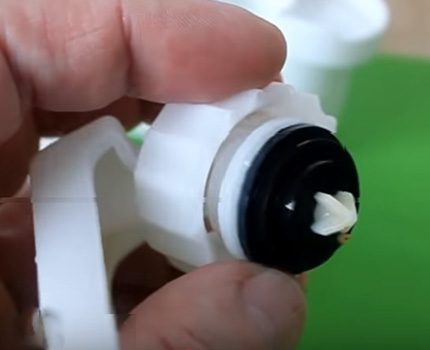
It is enough to disassemble the drain tank fittings, rinse components, replace worn parts, reassemble everything, and the system works as a debugged mechanism - without failures.
Installation repair methods
Together with the purchase of a toilet installation, it is advisable to immediately buy a spare repair kit. It may be needed after 10-12 years or 3-4 years after the start of the system. In order not to run and not to search for spare parts, you should always have them in the pantry / on the shelf with tools.
Finding a problem inside the drain tank
The volume of repair work will depend on what exactly broke. The most common problems encountered through the fault of fittings:
- Water continues to run after flushing is complete. The reason may be the accidental ingress of foreign objects into the drain tank - hair, cardboard, pieces of construction debris and other inclusions. The solution to the problem is to get bulk and drain mechanisms and eliminate the problem;
- Slowly water comes out of the tank after pressing the flush button. Damage to the harmonica of lifting the drain mechanism is possible. The way out is to replace the drain mechanism;
- Water does not accumulate in the tank - problems with the float are possible. It may come off the mount. The solution is to disassemble the system and replace the float;
- The valve does not completely block the water - change the membrane or replace the gasket.
It turns out that in most cases you need to look inside the drain tank without getting it out of the wall. This can be done by a home craftsman, with the instruction of dismantling the fittings.
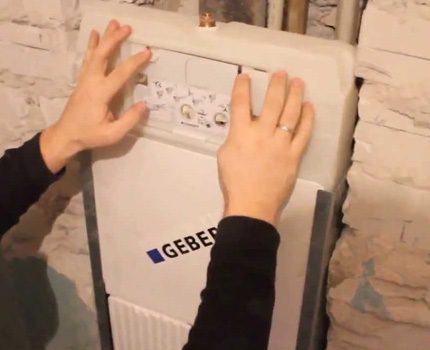
Flush Button Recovery
The flush button is mounted on a special frame and connected to the system using levers and cables. They are pneumatic and mechanical. It is important that the devices are reliable and of high quality for long life.
On sale you can see various models of buttons - with backlight, with two and with one key. They differ in size, color, shape and material of which they are made. But some options can be universal - approach installations of various manufacturers.
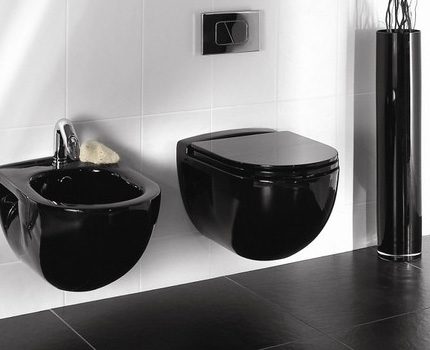
If the flush button does not work well, then you need to remove it and look in the audit window of the installation. It is possible that the air hose leading to the installation through the pneumatic button is loose. Or the button itself broke.
The solution to the problem depends on the situation - adjusting the hose or buying a new button. Often in specific model instructions the manufacturer not only describes the installation process, but also indicates which buttons are suitable.
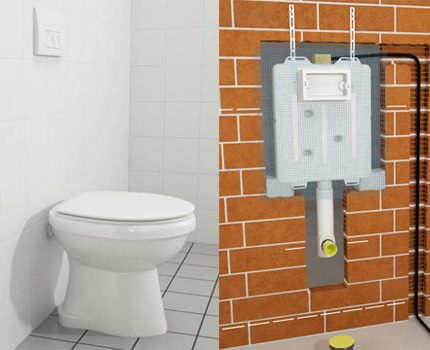
Breakdown Detection Methods
When you have to find a breakdown inside the installation, it is not necessary to break the wall. You can get the drain tank mechanism through the inspection window. Let’s take a closer look at how to do this using the Geberit installation example.
First you need to remove the decorative trim with the flush button by pressing down and pulling it towards you. Then you have to remove the frame on which the key is attached.
To do this, unscrew the screws, pull out the plastic pushers. Then, in a way that depends on the model and manufacturer of the plumbing, you will have to remove the partition by pressing on its latches. On this partition, a dismantling scheme for the drain tank fittings can be applied, which is used to clean the valves and check the gaskets-seals.
An important step is to shut off the water flowing into the drain tank. Otherwise, it’s possible by its actions to arrange a real disaster of a local scale - to flood not only your bathroom, but also the neighbors below.
Next, the bulk valve should be dismantled - you must first remove the rocker arm, and when reassembling, you will have to fall into the gearing of the flush valve and 2 fixation points with two rockers.
Then it was the turn of the filling valve itself, to which a flexible water supply pipe was supplied. He is carefully taken out. This valve controls the level of water filling in the tank - if you twist the plastic pin, you can raise higher or lower the float, which ensures filling the tank in the specified volume.
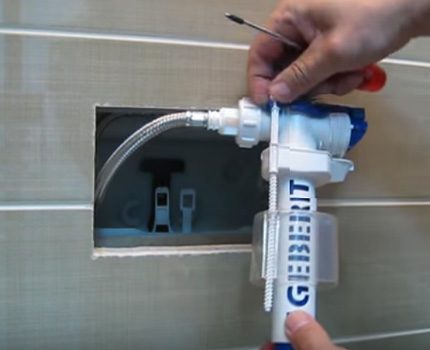
Now, next in turn is the removal of the drain valve retainer - for this, the wings are spread in opposite directions, which removes the part from the cordon.
It is necessary to dismantle a rather long flush valve - you can not do without partial dismantling inside the tank. To do this, holding the inside, you need to unscrew the upper part and lower the second link to the side.
All - the valve is easily removed from the internal space of the drain tank built into the wall. It consists of two blocks - the upper one for small and the lower one for large discharge. There is a basket on the bottom of the valve, which, if it is necessary to replace the gasket, is easy to remove.

Now all the details need to be carefully inspected, washed under running water, to assess their condition for deterioration. Replace broken parts, gaskets. After eliminating breakdowns or scheduled cleaning of all parts of the valve, it is necessary to assemble all components in the exact reverse order.
If the condition of the mechanism is extremely poor, then you need to replace the whole mechanism with a new one, using new fittings for the drain tank.
It smells bad in the bathroom
Often you may encounter a situation where everything is in order with the bathroom ventilation system, but under the hanging toilet it flows and there is a disgusting smell of sewage in the room, and water may leak behind the tile inside the structure.
Here the problem may be related to violations of the rules wall mounted toilet and with nodes connecting the tank to the toilet and the toilet to the sewer.
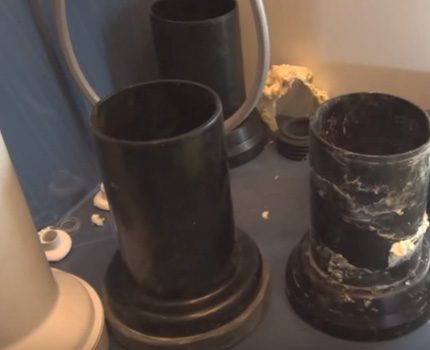
The fact is that the basis of these troubles may be in errors made even during installation. It is important that the piping is correctly installed before installing the installation. Here, the length of the supply pipe and the left sewer inlet matters.
In some installation models, the nozzles are short. This must be taken into account so that later one does not have to invent dubious schemes for sealing. Branch pipes from installation are most often with a diameter of 90 mm. They are placed through the adapter in the sewer, which is usually 110 mm.
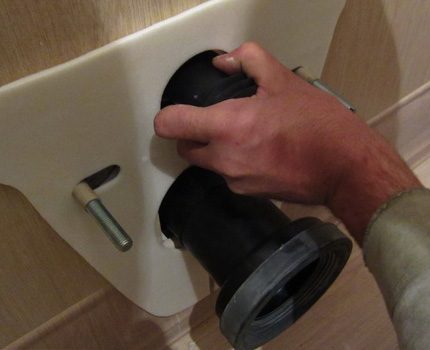
When the adapter for the toilet or installation pipe connecting the system to the sewer is short, it will be correct to buy a pipe from another manufacturer, a longer one. It will become excellent and everything will be airtight.
On the adapter, you should not save - everything should be tight here, there should be leaks. Some of this length is enough, while others, for the latest models, for example, Grohe, have short pipes.
Conclusions and useful video on the topic
Clip # 1. To disassemble the installation without destroying the wall of the bathroom is real. How to do it yourself:
Clip # 2. The appearance of an unpleasant odor may be the result of an error when connecting the toilet through the installation pipe to the sewer. You can fix this problem:
Clip # 3. When water began to appear under the hanging toilet, you need to find the failure of the installation:
Any breakdowns in the installation of the toilet can be repaired with your own hands. This is more effective than inviting craftsmen with crooked hands, and cheaper than the services of a professional plumber. And acquaintance with the installation system may come in handy in the future when there is a need for an operational repair.
You can talk about how you personally repaired the supporting frame of the hanging toilet and share useful information in the block below. Please comment and ask questions.

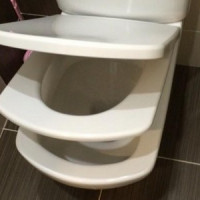 Repair of the toilet lid: frequent breakdowns and methods for their elimination
Repair of the toilet lid: frequent breakdowns and methods for their elimination 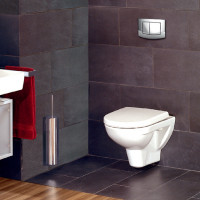 Repair of the installation for the toilet: possible malfunctions and methods for their elimination
Repair of the installation for the toilet: possible malfunctions and methods for their elimination 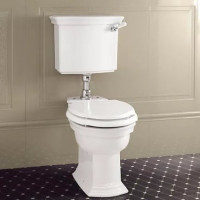 Why the toilet bowl sweats: the causes of fogging and how to eliminate them
Why the toilet bowl sweats: the causes of fogging and how to eliminate them 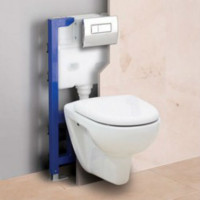 How to choose a toilet installation: overview of designs and tips before buying
How to choose a toilet installation: overview of designs and tips before buying 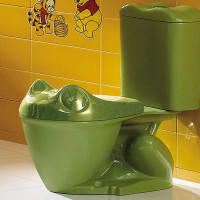 What to do if the drain tank does not hold water: causes and methods for troubleshooting
What to do if the drain tank does not hold water: causes and methods for troubleshooting 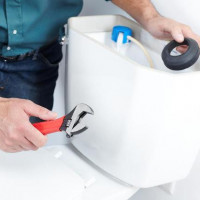 The toilet is leaking after flushing
The toilet is leaking after flushing  How much does it cost to connect gas to a private house: the price of organizing gas supply
How much does it cost to connect gas to a private house: the price of organizing gas supply  The best washing machines with dryer: model rating and customer tips
The best washing machines with dryer: model rating and customer tips  What is the color temperature of light and the nuances of choosing the temperature of the lamps to suit your needs
What is the color temperature of light and the nuances of choosing the temperature of the lamps to suit your needs  Replacement of a geyser in an apartment: replacement paperwork + basic norms and requirements
Replacement of a geyser in an apartment: replacement paperwork + basic norms and requirements
Installation costs five years already. Probably a successful one bought the kit, since for so many years no repair was needed. When buying, pay attention to the allowed weight. They put a good filter on the water pipe, since the water in our house comes with a high rust content. By the way, the filter has to be changed very often, which may be why plumbing works for a long time without repair.
I faced such a problem: the water did not stop after the flush. I fussed with this tank all evening and the second day, spent a lot of energy, time.Maybe, of course, my hands are in the wrong place, but for the future I decided for myself that everyone should do his own thing. The next time it’s better to immediately call the wizard. Here, although everything is easily described, but in fact it is a lot of time for a person who has never encountered such a thing.
Thank you so much! Thanks to you, everything worked out for me.
Help with advice. I want to do it on my own. After a set of water, water flows into the toilet through a flush valve. What and how to do? Tank "Grokh" with one button. Thank.
Hello. Most likely, a problem with the seal.
Installation "Visa" in a new building. After installation, the year was used only occasionally, because until we live. Water stopped flowing in the tank after draining. It is necessary to block the inlet tap to supply water to the apartment and open it again - it is typed. Then everything repeats. What is the reason - are there knowledgeable people?
The same nonsense with the installation of "Visa". Only used a couple of days, and then stopped filling after flushing))
Alexander, you need to squander (make oval) a little 2 holes in which the lever is held which is connected to the float. So it is necessary that the lever presses the gasket a little less. Then, at the moment of opening after draining the water, the pressure is released and the same thing happens as after closing / opening the water supply valve.
Installed the installation, when flushing water flows while holding the button. When you let go, it stops flowing. How to configure so that when pressed the whole barrel merges? thank
Hello. You will find this information in this article on our website. Please read.
Everything worked out! thank!..
Here is the problem with the flow of water into the toilet when it is at rest. A small amount, but still - it’s the same money that is flushed into the toilet ...
When I wash away rusty water, what can I do? Normal water runs out of the tap. Since the barrel is removed behind the wall, it cannot be removed and cleaned, can there be any means to remove rust?
Hello. For ceramic tanks - acid-based products, for metal and plastic - something alkaline. The funds are full in any household department of stores - Sanita, Silit, various gels, capsules and more. You can, by analogy with a washing machine, use folk remedies - lemon, soda, vinegar, Coca-Cola.
Good afternoon! Thank you for the complete and useful information for all. I just have a problem with a violation of the system for draining the working fluid into the sewer riser. Background: we installed the ceresit wall hung toilet, everything works well, sometimes after draining the water does not fill up in the tank, but when you press it 3 times, the water draws in. Sometimes I heard how water is dripping into the tank, when opening the hatch it is clear that when filling it drips from the inside (I don’t know for sure). And recently, a plumber ksk came, saying that we are drowning the neighbors from below.
They opened part of the walled riser (the problem was with the riser) and along the way he saw that the water supply from the common pipe of the house to the toilet was through a flexible hose, and according to the rules, it was necessary that it be a plastic pipe. Because this hose can break through at any time from pressure or wear and tear, metal corrosion, etc. - offered to replace.
Question:
1. What is the likelihood of a breakthrough of a flexible hose (water is collected through it into the tank and that's it).
2. After that, we partially closed the tap from this hose (to reduce the pressure of the water) - will this help?
3. But there was another problem (from a partial shutdown of the water supply or not - I don’t know), but the water in the toilet began to leave slowly for a long time, visually there was enough water, but it seemed that there wasn’t enough strength (how to write correctly, it’s not clear) and even it’s just that when a bucket of water was poured out of the floor, the dirty water was longer than usual above the usual level and left for a long time. The mole fell asleep at night - the situation has not changed.
The main question for all experts: what to do? Change hose to plastic pipe? Open the water supply? Or something different?
Hello!
I have two German wall hung toilets with a Geberit installation. Work 20 years. One toilet stopped draining low water. When pressed, nothing merges. What could be? How to fix the malfunction?